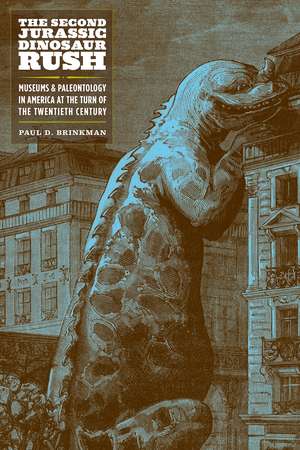The Second Jurassic Dinosaur Rush: Museums and Paleontology in America at the Turn of the Twentieth Century
Autor Paul D. Brinkmanen Limba Engleză Paperback – 21 dec 2020
Reconsidering the fossil speculation, the museum displays, and the media frenzy that ushered dinosaurs into the American public consciousness, Paul Brinkman takes us back to the birth of dinomania, the modern obsession with all things Jurassic. Featuring engaging and colorful personalities and motivations both altruistic and ignoble, The Second Jurassic Dinosaur Rush shows that these later expeditions were just as foundational—if not more so—to the establishment of paleontology and the budding collections of museums than the more famous Cope and Marsh treks. With adventure, intrigue, and rivalry, this is science at its most swashbuckling.
Preț: 325.93 lei
Nou
Puncte Express: 489
Preț estimativ în valută:
62.38€ • 64.44$ • 51.91£
62.38€ • 64.44$ • 51.91£
Carte tipărită la comandă
Livrare economică 25 martie-08 aprilie
Preluare comenzi: 021 569.72.76
Specificații
ISBN-13: 9780226752167
ISBN-10: 022675216X
Pagini: 345
Ilustrații: 31 halftones, 8 line drawings
Dimensiuni: 152 x 229 x 36 mm
Greutate: 0.53 kg
Editura: University of Chicago Press
Colecția University of Chicago Press
ISBN-10: 022675216X
Pagini: 345
Ilustrații: 31 halftones, 8 line drawings
Dimensiuni: 152 x 229 x 36 mm
Greutate: 0.53 kg
Editura: University of Chicago Press
Colecția University of Chicago Press
Notă biografică
Paul D. Brinkman is head of the History of Science Research Lab and curator of special collections at the North Carolina Museum of Natural Science as well as adjunct associate professor in the Department of History at North Carolina State University.
Cuprins
List of Illustrations
Acknowledgments
Introduction
1 Scientists Wage Bitter Warfare
2 Osborn’s Sorry Valentine
3 Wortman Assumes Charge
4 Most Colossal Animal on Earth
5 An Overconfident Start
6 The Monster of All Ages
7 A Monkey and a Parrot of a Time
8 Fossil Wonders of the West
9 Watch the Dinosaur Shrink!
10 Hatcher Heads West
11 Last Days in the Jurassic
12 Putting Dinosaurs in Their Places
Conclusion: What’s the Rush?
Epilogue
Appendix
Notes
Bibliography
Index
Acknowledgments
Introduction
1 Scientists Wage Bitter Warfare
2 Osborn’s Sorry Valentine
3 Wortman Assumes Charge
4 Most Colossal Animal on Earth
5 An Overconfident Start
6 The Monster of All Ages
7 A Monkey and a Parrot of a Time
8 Fossil Wonders of the West
9 Watch the Dinosaur Shrink!
10 Hatcher Heads West
11 Last Days in the Jurassic
12 Putting Dinosaurs in Their Places
Conclusion: What’s the Rush?
Epilogue
Appendix
Notes
Bibliography
Index
Recenzii
“Ever wonder why the great museums of New York City, Pittsburgh, and Chicago are filled with Jurassic dinosaurs? Brinkman’s account looks at when early dinomania spurred museums to try to get the biggest and best dinosaurs for their displays, setting the foundation for exhibits that still stand today.”
“In the years around 1900, major U.S. museums raced to find the best and biggest dinosaurs and put them on display. It was a decisive decade for paleontology, when the public first got a spectacular view of the strangeness of the prehistoric world, and dinomania first took off. Based on thorough archival research, this is a fascinating story of ambitious administrators and scientists, their moneyed patrons, and the often invisible technicians and fieldworkers on whom the whole project depended.”
“This superbly researched and illustrated book carries the subject of dinosaur paleontology from the end of the much discussed Marsh-Cope era to just short of the discovery of Dinosaur National Monument. It is a period of the establishment of museums in New York, Pittsburgh, and Chicago to exhibit the mounted skeletons. From the archives, including many letters from the field collectors like Hatcher to museum directors like Holland, one learns details of the collecting at major quarries like Bone Cabin Quarry and Sheep Creek, but also of the scientists’ often complicated relationships with one another and with their superiors. At the end, one feels personally acquainted with the personalities in this engaging book.”
“A detailed example of how superlative specimens have played essential roles in museum reputation and identity.”
“Comprehensive and accessible. . . . From daily camp life to museum politics, Brinkman has ably documented a time of major change in dinosaur science, one that provides the context for paleontology as we know it today.”
“[The Second Jurassic Dinosaur Rush] explores an exciting period in paleontological history and the many intrigues that accompanied this frenzy of paleontological research. . . . Highly recommended."
“Excellent and extraordinarily detailed. . . . What does this book do for the field of historical paleontology in general? It really raises the bar, plumbing an enormous quantity of source material and expertly weaving a story of scientific discovery, egos, personalities, and museum politics with that of a changing socioeconomic and academic landscape. Brinkman’s book will serve as an important resource for people interested in the history of Jurassic dinosaur research, in the lives and careers of such fossil hunters and scientists as Wortman, Reed, Osborn, Hatcher, Riggs and so on, in the history of how fossils are represented to the public, and in how American museums were shaped by the personal and political motivations of those behind the scenes. . . . Wow, what a thorough job.”
“Groundbreaking.”
“Brinkman provides a flood of new data on American fossil collecting in a book that reads more like an Old West novel than a historical monograph. . . . Impressively researched. . . . A valuable contribution to the history of paleontology.”
“This well-written volume reads like a thriller and will fascinate any reader. . . . These real field collectors make fictional characters like Indiana Jones look like an armchair theoretician.”
“Brinkman paints an intricate portrait of paleontological fieldwork. No doubt, the author's own field experience helped to lend richness to his descriptions of day-to-day practice.”
